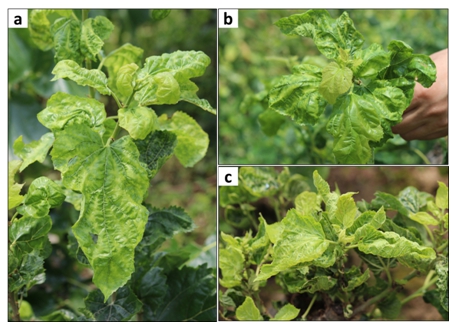分享到
Research Progress on Identification of Pathogen Associated with Mulberry Mosaic Dwarf Disease
Mulberry mosaic dwarf disease (MMDD) is a graft-transmissible syndrome long-known in China, where it can seriously affect silk farming industry. Infected mulberry plants showed severe dwarf symptoms on mulberry leaves such as mottling, deformation, curling and puckering showing a typical MMDD (Figure 1). Although studies on this disease have lasted for nearly a half century, the etiology is not yet clear.
Recently, the cooperation between the Institute of Plant Protection of CAAS and the Institute for Sustainable Plant Protection of Italian National Research Council has made a great progress in etiology research on MMDD. A novel geminivirus was identified from mulberry trees using next generation sequencing (NGS) technology. Experiment results revealed a close association of the geminivirus with MMDD, so we tentatively named this novel geminivirus as mulberry mosaic dwarf associated virus (MMDaV). The related research results have been published online in Journal of General Virology on May 6, 2015.
Rolling circle amplification (RCA) and polymerase chain reaction (PCR) with specific primers, followed by sequencing of eight independent full-length clones, showed that this virus has a monopartite circular single strand DNA (ssDNA) genome (~2.95 kb) containing seven Open Reading Frames (ORFs) in both polarity strands, as previously reported for geminiviruses. MMDaV genome codes for five and two putative proteins in the virion-sense and in the complementary-sense strands, respectively. As previously reported for members of the genera Mastrevirus and Becurtovirus, MMDaV replication-associated proteins are expressed through the alternative splicing of an intron, which was shown to be functional in vivo. A similar intron was found in the genome of citrus chlorotic dwarf associated virus (CCDaV) - a divergent geminivirus recently found in citrus. Based on pairwise comparisons and phylogenetic analyses, CCDaV and MMDaV appear to be closely related to each other, thus supporting their inclusion in a putative novel genus in the family Geminiviridae.

Figure 1 Symptoms of mulberry mosaic dwarf disease.
Recently, the cooperation between the Institute of Plant Protection of CAAS and the Institute for Sustainable Plant Protection of Italian National Research Council has made a great progress in etiology research on MMDD. A novel geminivirus was identified from mulberry trees using next generation sequencing (NGS) technology. Experiment results revealed a close association of the geminivirus with MMDD, so we tentatively named this novel geminivirus as mulberry mosaic dwarf associated virus (MMDaV). The related research results have been published online in Journal of General Virology on May 6, 2015.
Rolling circle amplification (RCA) and polymerase chain reaction (PCR) with specific primers, followed by sequencing of eight independent full-length clones, showed that this virus has a monopartite circular single strand DNA (ssDNA) genome (~2.95 kb) containing seven Open Reading Frames (ORFs) in both polarity strands, as previously reported for geminiviruses. MMDaV genome codes for five and two putative proteins in the virion-sense and in the complementary-sense strands, respectively. As previously reported for members of the genera Mastrevirus and Becurtovirus, MMDaV replication-associated proteins are expressed through the alternative splicing of an intron, which was shown to be functional in vivo. A similar intron was found in the genome of citrus chlorotic dwarf associated virus (CCDaV) - a divergent geminivirus recently found in citrus. Based on pairwise comparisons and phylogenetic analyses, CCDaV and MMDaV appear to be closely related to each other, thus supporting their inclusion in a putative novel genus in the family Geminiviridae.

Figure 1 Symptoms of mulberry mosaic dwarf disease.
This work was supported by grants from the Earmarked Fund for China Agriculture Research System, the Special Fund for Agro-scientific Research in the Public Interest, and the National Natural Science Foundation of China (NSFC).
For more information, please visit:
http://jgv.sgmjournals.org/content/early/2015/05/06/vir.0.000175.abstract
For more information, please visit:
http://jgv.sgmjournals.org/content/early/2015/05/06/vir.0.000175.abstract
Latest News
-
 Apr 18, 2024Opening Ceremony of the Training Workshop on Wheat Head Scab Resistance Breeding and Pest Control in Africa Held in CAAS
Apr 18, 2024Opening Ceremony of the Training Workshop on Wheat Head Scab Resistance Breeding and Pest Control in Africa Held in CAAS -
 Apr 03, 2024IPPCAAS Co-organized the Training Workshop on Management and Application of Biopesticides in Nepal
Apr 03, 2024IPPCAAS Co-organized the Training Workshop on Management and Application of Biopesticides in Nepal -
 Mar 28, 2024Delegation from the School of Agriculture and Food Science of University College Dublin, Ireland Visit to IAS, CAAS
Mar 28, 2024Delegation from the School of Agriculture and Food Science of University College Dublin, Ireland Visit to IAS, CAAS -
 Mar 25, 2024Director of World Food Prize Foundation visited GSCAAS
Mar 25, 2024Director of World Food Prize Foundation visited GSCAAS -
 Mar 20, 2024Institute of Crop Sciences (ICS) and Syngenta Group Global Seeds Advance Collaborative Research in the Seed Industry
Mar 20, 2024Institute of Crop Sciences (ICS) and Syngenta Group Global Seeds Advance Collaborative Research in the Seed Industry
